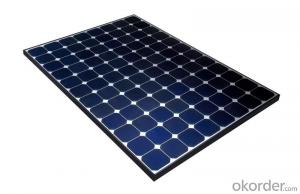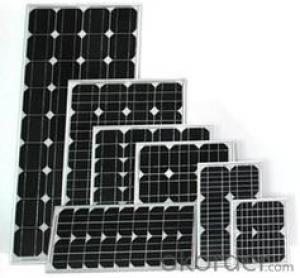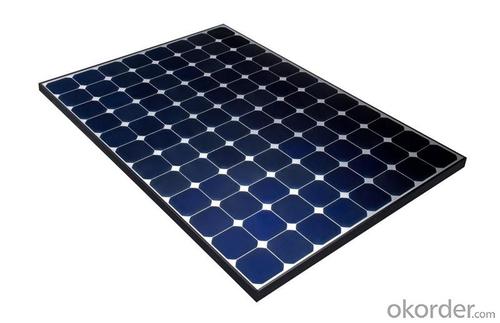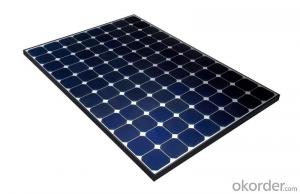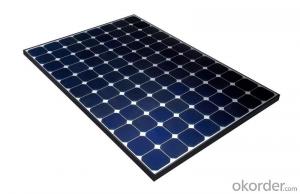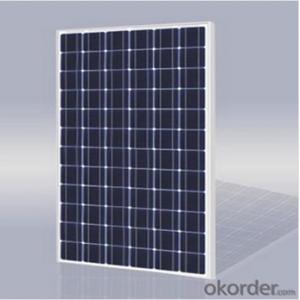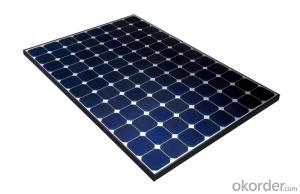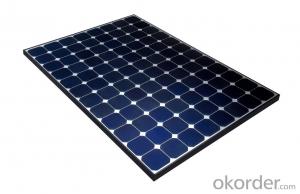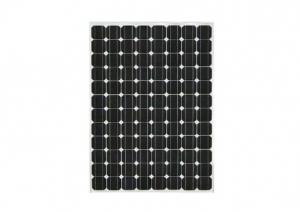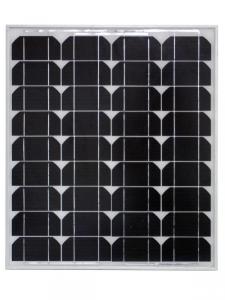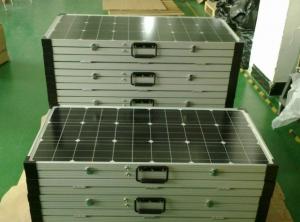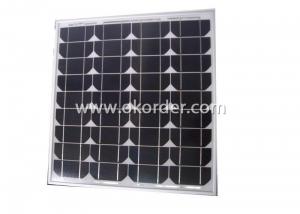Solar Panels for Home - CNBM Poly 225W Solar Panel with TUV UL CE Certificate for Residential
- Loading Port:
- Shanghai
- Payment Terms:
- TT OR LC
- Min Order Qty:
- 225 watt
- Supply Capability:
- 1000 watt/month
OKorder Service Pledge
OKorder Financial Service
You Might Also Like
Specification
CNBM Poly 225W Solar Panel with TUV UL CE Certificate For Residential
Introduction
Each module is rated by its DC output power under standard test conditions, and typically ranges from 100 to 365 watts. The efficiency of a module determines the area of a module given the same rated output – an 8% efficient 230 watt module will have twice the area of a 16% efficient 230 watt module. There are a few solar panels available that are exceeding 19% efficiency. A single solar module can produce only a limited amount of power; most installations contain multiple modules. A photovoltaic system typically includes a panel or an array of solar modules, a solar inverter, and sometimes a battery and/or solar tracker and interconnection wiring.
Micro-inverted solar panels are wired in parallel which produces more output than normal panels which are wired in series with the output of the series determined by the lowest performing panel (this is known as the "Christmas light effect"). Micro-inverters work independently so each panel contributes its maximum possible output given the available sunlight.[6
A solar cell, or photovoltaic cell (in very early days also termed "solar battery"[1]– a denotation which nowadays has a totally different meaning, see here), is an electrical device that converts the energy of light directly into electricity by thephotovoltaic effect, which is a physical and chemical phenomenon.[2] It is a form of photoelectric cell, defined as a device whose electrical characteristics, such as current, voltage, or resistance, vary when exposed to light. Solar cells are the building blocks of photovoltaic modules, otherwise known as solar panels.
Solar cells are described as being photovoltaic irrespective of whether the source issunlight or an artificial light. They are used as a photodetector (for example infrared detectors), detecting light or other electromagnetic radiation near the visible range, or measuring light intensity.
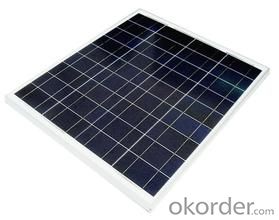
Suggested application
Home lighting business lighting,
Garden lighting, pavement lighting
Farmer household lighting
Decorative water pump
Traffic signal lighting
Industry area
Business area
Solar Power Plant
Product feature
Modules are made of Monocrystalline or Polycrystalline Silicon cell.
Materials and color of the solar panel frame: Clear anodized aluminum alloy type 6063T5 Universal frame; Silver-white color;
The output connection gathers the coupling: Selects conforms to the IEC-612615; 2005, class II, IEC61730 international standard; Airtight waterproofing binding clamp;
Module seal structure: The surface is thick, the high diaphanous rate armored glass with solar cell board special-purpose 3.2mm becomes after the high temperature lamination craft. The back selects has waterproof and anti- aged performance fine TPT materials. The entire block battery board has, the waterproofing, the anti- aging airtight and so on the fine performance;
Power tolerance: +/-3%
Packaging
International standard cartons (according to the requirements of customers)
- Q: I know that if I put solar panels in my home I will get 30% back from the govt. Does that mean if I pay 2K I will get back around a 3K check? Or will my income play a roll where I may not get back as much?
- The energy credits are non-refundable. That means that they only reduce your existing tax liability. If the credit is more than your tax liability, the excess is lost. Examples: If your tax liability is $5,000 and you qualify for a $3,000 non-refundable credit, it reduces your tax liability to $2,000. If you had paid in $5,000, you would get a refund for $3,000. If you had paid in $3,000, you'd get a refund of $,000. If your tax liability was $2,000, a $3,000 credit would wipe it out and the other $,000 would be lost forever. If you had paid in $2,000, you'd get a refund for $2,000. If you had paid in $,000, you'd get a refund of $,000. BTW, check your math. 30% of $2k is not $3,000.
- Q: How do solar panels impact air pollution?
- Solar panels have a positive impact on air pollution as they produce clean energy without emitting harmful pollutants or greenhouse gases into the atmosphere. By replacing fossil fuel-based energy sources, solar panels help reduce air pollution and improve air quality, resulting in a healthier and more sustainable environment.
- Q: If my school uses 88240kWh of electricity per month and I have 000 50W solar panels running for 6 hours a day, does it mean it will take 88240kWh / {{[(50W x 3600s)*000]/000}kWh x 6} number of hours to generate that much electricity (88240kWh)?
- running six hours a day doesn't mean much. You need to look at the solar insulation charts for your school's geographical location to come up with a better factor. The easiest number for you to use is sun hours. For example, Washington DC averages 4.23 hours. Do a Yahoo search for sun hours and you should find lots of charts. Solar panels rated at 50W give this output at full sun near noon at full brightness (no clouds). The sun hour factor makes it easy to find the equivalent number of full brightness hours. So, using Washington DC as an example you have: 000 panels * 50W * 4.23 sunhours/day = 634kWh a day on average. You state your school uses 88240kWh/month which is 6274kWh a day. This would mean you need ten times more solar panels since there is no way to get more daylight. Be careful to put in all the units in your formula and cancel them out to make sure you don't end up with a nonsense result. The title of the question would be answered as followed: 50W/000 * 4.23 sunhours/day = 0.63kWh/day or 9kWh per month or 228kWh a year. These are annual averages. If you wanted a specific month, you would need the sun hours for that month. Hope this helps.
- Q: Do solar panels require a backup generator?
- No, solar panels do not require a backup generator. They generate electricity from sunlight, so as long as there is sufficient sunlight, they can provide continuous power without the need for a backup generator.
- Q: I just moved into somewhere with solar panels but don't really understand them...all I know is that they heat the water.Do I still have to turn the hot water on with the solar panels or do they heat it automatically or do they store the energy until I turn on the hot water?!
- Custom solar-heating systems are unique. Does yours have a circulating pump? Does it have a storage tank? Is the fluid that goes to the panels separated from the household water and transfers heat through a heat-exchanger radiator, and the fluid has antifreeze in it? If it does, is the antifreeze of the variety that won't poison your family if there is a leak? Does your system have a thermostat-controlled pump that turns on when the water in the panels are hot? Does it have a limit-thermostat to turn off the pump when water in the storage tank is hot? There are many more variations to operation of solar-heating panels. Find out who designed it or who knows how to operate it and ask them.
- Q: How much is the cost of solar panels including installation for my home so that I can have low monthly power bills.
- You can start as small as 7,500. It all according to how much you want to run off solar and your Environment. You can move into Solar slowly as the technology Improves every six months or so.
- Q: Solar panel for battary charging
- What you are stating is that the battery you have will operate the UPS for about 2 hours before it is drained past the point of no return (technically 2.82 hours, but that would be a dead battery - most well-designed UPS systems cut off when the battery gets below about a 30% charge so that battery is not damaged. Lead-Acid batteries have about a 0%/month self-discharge rate if there is no load connected. The very best systems are as low as 3%, the worst are over 20% - and all at a 'normal' temperature. So, you will need a maintenance charger of about ten (0) watts or so - amp will be more than enough. And about any solar panel will handle that much with the proper charging connection.
- Q: Since plants have been populating this earth for the past 475 million years I think they have evolved to gain the most sun with their greenery. If scientists used heat sensors to find the hot spots of trees and trim all of the leaves that don't quot;providefor the plant, then maybe that trimmed tree could be used to become a solar quot;panelquot;. I believe that each individual leaf could be replaced by a small solar panel and the wood of the tree would be wiring that would root all of the solar panels to a generator.
- I don't know much about solar power. This does however seem to be a very interesting idea. But I'd imagine that the complexity of building such a structure would be far more difficult that just laying thousands of large panels in an area. The shadow from higher panels may also have an adverse affect on the lower panels. Consider the tiny panels that do provide energy and compare them to a large panel that is easier to make.
- Q: i really love the idea of solar and want to start out small, so i'm new to this.I plan on getting an 85w panel to charge my laptop. what other equipment is needed to accomplish this?would i need to get a battery or does the solar panel hook directly to the laptop. Does one end just lead to a conventional outlet similar to a wall outlet?could someone please give me a detailed explanation with options about this? i would greatly appreciate it.
- humm..... .need HUGE solar panel (alot) 2. wires 3. aligato clips . put the panels on the roof 2. use the aligator clip to clip the wire from the panel to the bars of the pluger of the comp. charger 3.tada mark me best:)
- Q: Just curious.
- Create okorder /
Send your message to us
Solar Panels for Home - CNBM Poly 225W Solar Panel with TUV UL CE Certificate for Residential
- Loading Port:
- Shanghai
- Payment Terms:
- TT OR LC
- Min Order Qty:
- 225 watt
- Supply Capability:
- 1000 watt/month
OKorder Service Pledge
OKorder Financial Service
Similar products
Hot products
Hot Searches
Related keywords
